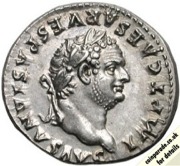 The 79AD Denarius - Titus / Kneeling Captive
The 79AD Denarius - Titus / Kneeling CaptiveSilver Denarius of Emperor Titus. Struck at the Rome Mint around June-July 79 AD.
The Obverse shows a laureated Emperor Titus facing right. Legend "Titus, as Augustus, AR Denarius. June-July 79 AD. IMP T CAESAR VESPASIANVS AVG".
 The Reverse shows a Jewish captive kneeling, facing right, in front of trophy of arms. A Roman soldier is in the background. Legend "TR POT VIII COS VII".
The Reverse shows a Jewish captive kneeling, facing right, in front of trophy of arms. A Roman soldier is in the background. Legend "TR POT VIII COS VII".A beautiful coin.
Image credit: CNG Coins
Mintage: Not known
Minted at Roman Mint
More information (monarch, year, mint, country, category) can be found below coin listings.
Below are some coins currently being offered on eBay. As an eBay Partner, We may be compensated if you make a purchase.
List items on:
List items on:
Titus (Emperor 79AD-81AD)
Titus Caesar Vespasianus was the son of the Emperor Vespasian and ruled from 24 June 79AD to 13 September 81AD. He was born in Rome on 30 December 39AD as Titus Flavius Vespasianus.He was well known as a military commander in the First Jewish–Roman War. In 70AD he captured Jerusalem, destroying the city and second temple for which he was awarded a triumph - the Arch of Titus. Titus was married a few times and had a controversial relationship with the Jewish queen Berenice, sister of Agrippa II.
As Emperor he was considered a good Emperor, probably best known for completing the Colosseum and dealing with the eruption of Mount Vesuvius in AD 79. Titus ruled for only two years before dying of a fever aged 41. He was succeeded by his younger brother Domitian.
Official title: TITVS FLAVIVS CAESAR VESPASIANVS AVGVSTVS.
Category: Roman
The Roman Empire was one of the largest Empires in history, covering most of Europe, Britain, parts of Asia, the Middle East and North Africa. It was in existence from 27BC to 476AD, more than 500 years. And all these places used Roman coins throughout the era.Originally coins were minted only in Rome, but by the third Century there were mints in other countries too. These mints sometimes produced more than 2 million coins per month to meet demand. Coins typically depicted the Emperor on one side and some other image or letters on the other. During the Empire, more than 10,000 different types of coins were created using copper, silver and gold.
Roman coins are usually classified as:
- Roman Republican Coins (about 300BC - 27BC)
- Roman Imperial Coins (27BC - 96AD)
- Roman Imperial Coins (96AD - 235AD)
- Roman Imperial Coins (235AD - 476AD)
- Roman Provincial Coins
The Denarius was the standard Roman silver coin and there were a range of others. As a guide, in the early republic (after 211BC) there was the Sestertius (=4 denarii), Dupondius (=5), As (=10, a tenner), Semis (=20), Quincunx (=24), Triens (=30), Quadrans (=40), Uncia (=120) and Solidus (=1000, it was gold). Values fluctuated later due to debasement and inflation.
The exchange values were as follows:
1 gold aureus = 25 silver denarii
1 silver denarius = 16 copper asses
1 brass sestertius = 4 copper asses
1 brass dupondius = 2 copper assses
1 copper as = 2 copper semisses (or 4 copper quadrantes)
The standard gold coin was the Aureus and was equal to 25 denarii or 100 sestertii. It's not far off the weight of a modern gold sovereign. The Aureus was introduced by Julius Caesar around 49BC and was the principal gold coin until about the 4th century when it was replaced by the gold Solidus.
The great part of this is that you can put together a really nice Roman coin collection with very little money, as many coins (although not all) are common and inexpensive. The coins are the best part of 2000 years old and are exciting to collect.
For more information see our articles:
Which Mint: Roman Mint
The origins of the Rome mint are from the manufacture of a silver coin near to the Temple of Juno Moneta back in 269BC. Juno was the personification of money.Due to the size of the Roman Empire, Rome could not produce all the coins needed and Roman mints were set up in 27 locations, and there were more than 600 provincial mints scattered about the Empire. During overseas campaigns, Generals such as Caesar and Marc Anthony would mint their own coins to pay their armies.
Mint marks were used on the coins to differentiate the mint of manufacture.
Country of Origin: Roman Empire
The Roman Empire ran from 27BC to 476AD and was the post-Republican period of ancient Rome. It covered a large territory of Europe, Northern Africa, and Western Asia. It was ruled by an Emperor.







